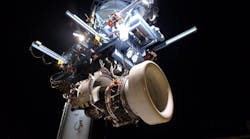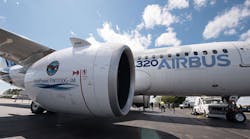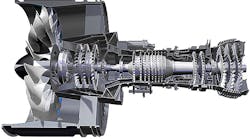Pratt & Whitney reported success for a new, geared-turbofan (GTF) engine propulsor technology, following more than 175 hours of ground testing. The tests were conducted at P&W’s West Palm Beach, Fla., engine center, and come 10 years after the group first successfully demonstrated the GTF.
The demonstrator used an existing development engine from a certified geared turbofan product to validate the performance capability of a second-generation, “ultra-high bypass” fan design. The engine successfully operated in a design space never before demonstrated, with significantly fewer, lower-pressure ratio blades than the current production engine, and a shorter duct inlet.
The rig and engine tests are expected to demonstrate technologies that will help reduce fuel burn by an additional 2%.
P&W noted that an important element of the new technology maturation is developing and applying computational fluid dynamics (CFD) tools that provide accurate predictions and design guidance toward “rig-to-engine scalability” and optimized performance.
The engines previously underwent 275 hours of fan-rig testing during 2014-2015.
According to Pratt & Whitney, the tests are being carried out as part of the Federal Aviation Administration's Continuous Lower Energy, Emissions and Noise (CLEEN) program, which promotes and shares costs toward environmental goals in the development of new aircraft and engine technologies, and alternative jet fuels.
According to Alan Epstein, vice president of Technology and Environment for Pratt & Whitney, "We are working to make sure the next generation GTF engine – already a game-changer – remains on the cutting edge of performance and sustainability."
Geared turbofan engines are configured with the engine fan separated from the low-pressure compressor and turbine, so that each module operates at optimal speeds. The result is lower engine weight and greater fuel efficiency. Pratt & Whitney claims its GTF engines offer delivers 16% better fuel efficiency, 50% lower NOx emissions than the regulatory standard and a 75% smaller “noise footprint.”
The GTF engines have been adopted as the exclusive engine for the Bombardier CSeries, Mitsubishi Regional Jet, and Embraer E-Jets, and as an option on the Irkut MC-21 and Airbus A320neo.









